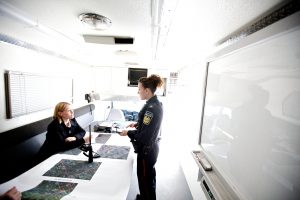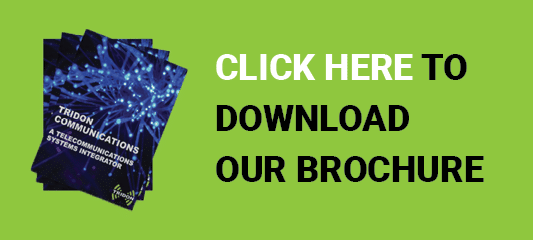In Alberta, and all across Canada, the radio frequency (RF) spectrum is a valuable resource. Every aspect of heavy industry and our institutions – from oil and gas to manufacturing and construction; including Hospitals, Universities and Government – rely on it to keep teams connected, communicating and safe. First responders, tourism operators, cellular carriers, manufacturers and utilities providers are just a few of the other entities who make use of the radio spectrum to accomplish their various missions.
How Frequencies Differ
The frequency you use to communicate will directly impact how you communicate, and what information you can transmit and receive. Generally, lower frequencies can travel further, making them an ideal choice for outdoor and long-distance communications. But what you get in range, you lose in penetrating power. This means that barriers like concrete and steel can interfere with a signal. You also lose some capability to transmit data; as a result, lower frequencies are generally used for voice-only communications.
Higher frequencies, on the other hand, offer more bandwidth, meaning you can transmit voice and a broad range of data. They also offer a great deal of penetrating power, meaning signals can travel through concrete, steel, and other barriers without experiencing the same level of signal degradation. This makes them a good choice for indoor communications (warehouses, hotels, refineries, etc.), but the trade-off is that they aren’t ideal for long-range communications unless supported by a communications infrastructure.
You Need a License
Managers experienced with two-way radios, point-to-point data and cellular communications know this already, but for everyone else: Yes, you need a license to use much of Canada’s RF spectrum. ISED (Innovation, Science and Economic Development) Canada – formerly Industry Canada – requires this because the spectrum is a valuable resource. With so many public sector agencies and private sector organizations needing some kind of private communications solution, ISED Canada regulates licensing to ensure equitable access, security, and reliability. The applications are long, and process becomes increasingly complicated as the scope of your operational needs grows. If you don’t have an experienced licensing expert on staff, Tridon can help you navigate the process. Contact Us if you’d like to learn more.
The Most Common Frequencies in Use
Your operational needs will dictate what equipment and what frequencies you end up using. Here are some of the most common being used in Alberta, and all across Canada.
VHF (138 to 174 MHz)
VHF stands for ‘Very High Frequency’ and is a standard of PTT (push to talk) voice communications. It’s well suited for long-range communications and is commonly used by the ground crew at airports for air-to-ground communication and by vehicle fleets in the transportation and logistics industries. If you’re on a bus headed from Edmonton to the Fort McMurray Oil Sands, chances are high that the driver is using a VHF radio. Finding available frequencies can be a challenge, however, because of how many different groups are using it.
UHF (406 to 470 MHz)
UHF stands for ‘Ultra High Frequency’, and is commonly used for in-building, PTT, voice communications because of the penetrating power it offers. UHF two-way radios can be found in a range of business environments across Alberta. Security teams in Calgary’s Saddledome and West Edmonton Mall use them; refinery workers also use them all over the province, from Edmonton to Fort McMurray. And, as an added bonus, the bandwidth offered by UHF communications is enough to support some data applications, like SCADA.
700 MHz
ISED Canada has dedicated frequencies in the 700 MHz band to public safety agencies and those organizations supporting them. There has been a fair amount of uptake in Alberta, most notably with the creation of AFRRCS (the Alberta First Responder Radio Communications System). The bandwidth provided by the 700 MHz frequency band also makes it a viable option for some data applications, like transmitting video, adding another tool to the public safety communications kit.
800 MHz
This frequency band was used by public safety organizations to handle their trunked two-way radio systems (systems like Motorola’s Capacity Max). But, with ISED dedicating the 700 MHz band for public safety use, systems dedicated to private sector use (most notably Alberta’s oil and gas sector) have moved in to make use of the spectrum.
900 MHz
This portion of the spectrum is often used for remote and rural WIFI access and has a major benefit of being ‘license-free’. That means users don’t have to pay regulatory fees to ISED to make use of it. The drawback of this is privacy and reliability. With the spectrum being open to any and all who need it, data transfer rates may slow down during peak traffic times. In addition to rural WIFI, this part of the spectrum is often used to boost in-building WIFI signals in schools, hotels, college and university campuses, and anywhere else open access to the internet is available.
2.4 GHz
Another license-free portion of the spectrum, the dominant use of the 2.4 GHz band is for ubiquitous WIFI.
3.65 GHz
A license-required portion of Canada’s spectrum, the 3.65 GHz band is generally used to support point-to-point and point-to-multipoint systems.
4.9 GHz
Like the 3.65 GHz band, this portion of the wireless spectrum is ideal for wireless broadband (point to point and point to multipoint). However, ISED has restricted access to this portion of the spectrum; only public safety agencies and organizations related to their efforts can access it. The high bandwidth makes it ideal for data transfer, so public safety agencies can use it for applications like video surveillance backhauling.
5.7 and 5.8 GHz
Very similar to the 4.9 GHz band, but this portion of the spectrum is open to the public, and ISED does not require you to have a license to use it. It’s a great frequency for point-to-point or point-to-multipoint broadband connectivity, and good system design can mitigate many of the challenges that come with sharing the spectrum.
6-30 GHz
This high end of the spectrum is great for top tier point-to-point and point-to-multipoint links when considerable levels of bandwidth are required. For example, large-scale operations in the oil and gas sector can connect their field offices to the main corporate network, providing remote offices with high-speed internet normally restricted to urban environments. High bandwidth connectivity also means these operations could monitor critical activity, like pipeline integrity and bitumen flow. However, the right SCADA equipment would need to be installed and properly programmed. Frequencies at this end of the spectrum require an ISED license, but having that license ensures reliability and privacy.
Getting Started
Getting access to the spectrum, especially the licensed portion, can be complicated. There is a great deal of need for bandwidth and connectivity, and only so much spectrum to go around. So, if you have questions about getting those licenses (and want to make sure you get the application right the first time), Contact Us. Tridon’s team is well versed on the in’s and out’s of ISED Licensing, and we would be happy to help.
Tridon is a full solution Telecom Systems Integrator with CSA certification and licensed by APEGA. Our Engineering, Service and Tower Divisions collaborate with customers to build engineered solutions including communications systems design, tower inspections and co-location, wireless broadband, fiber optic cabling, site security, and two-way radio communication. Tridon is a full solution Telecom Systems Integrator which includes our Engineering and Design team with APEGA certification. Our Engineering, Service and Tower Division will collaborate with your team to build an engineered solution including communications systems design, tower inspection and co-location, wireless broadband and more. And, as a TELUS Customer Care Centre, we are more than happy to handle both personal and business cellular needs, as well.








